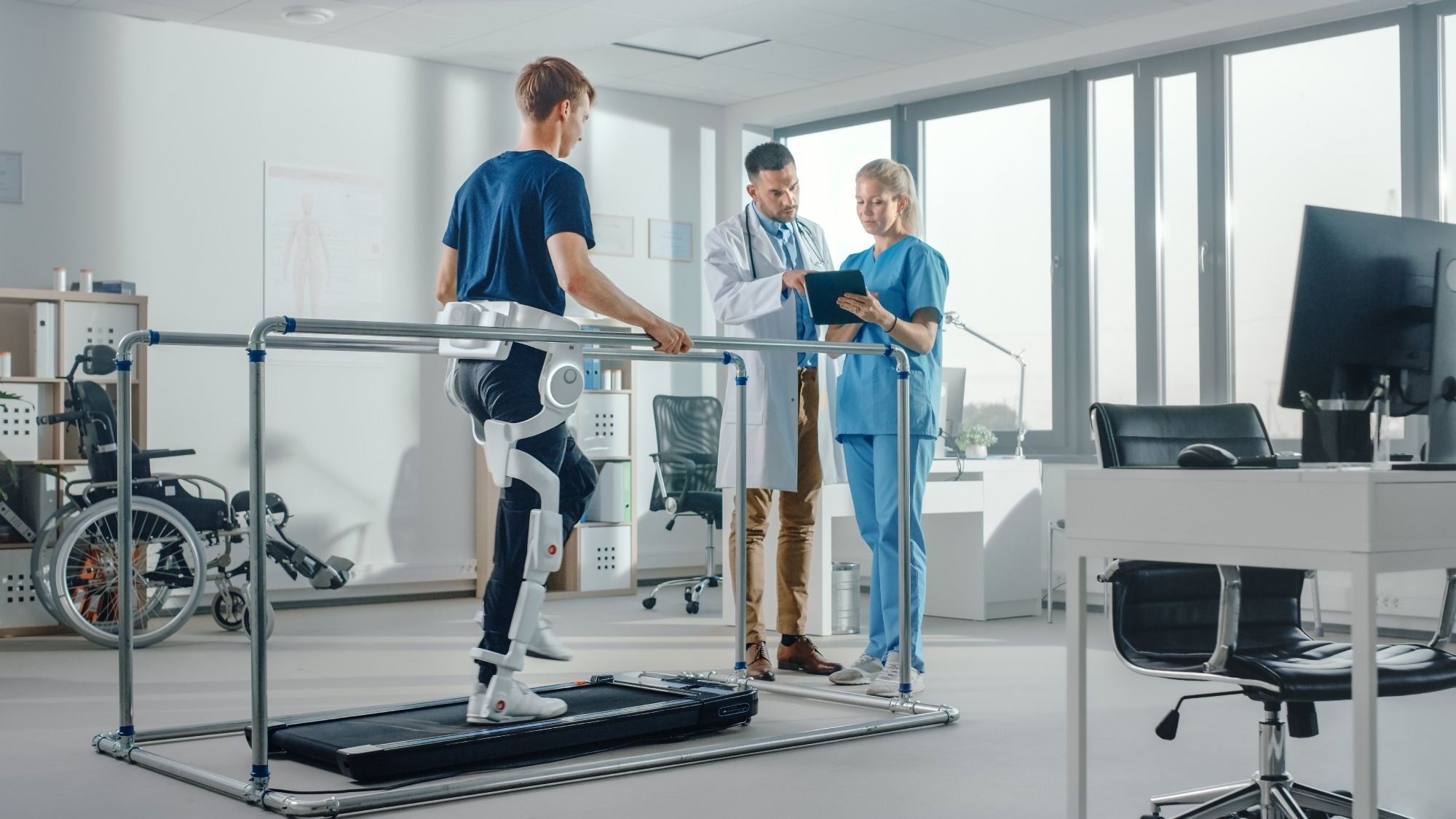In an article published in the journal Nature Communications, researchers from China and Sweden proposed a vision for developing high-performance next-generation wearable robots that can integrate with the human body and enhance its motor and sensory functions.
 Study: High-Performance Wearable Robots: Enabling Technologies and Future Directions. Image credit: Gorodenkoff/Shutterstock
Study: High-Performance Wearable Robots: Enabling Technologies and Future Directions. Image credit: Gorodenkoff/Shutterstock
Moreover, they reviewed the current state-of-the-art and the challenges of five breakthrough technologies that could enable high-performance wearable robots with embodiment: multi-modal fusion, human-in-the-loop control, neuromuscular interface, flexible electronics, and biomechatronic chip.
Background
Wearable robots are human-centered systems that combine robotic components with the human body, either in the form of prostheses or in the form of exoskeletons. They are developed to address deficits arising from limb loss or neuro-muscular diseases. This deficiency also involves sensory loss, which affects an individual's social interactions and autonomy. However, existing wearable robots face numerous limitations, such as poor functionality and intelligence, lack of user interaction, artifacts due to skin movement, and deficiency in information acquisition, transfer, and processing.
Deep learning is a subfield of machine learning that uses artificial neural networks to learn from data and perform tasks such as classification, regression, generation, and reinforcement learning. They work as per the structure and function of biological brains, which consist of interconnected neurons that process and transmit information through electrical and chemical signals. Moreover, they can handle large and complex datasets, such as images, speech, text, and video. Furthermore, this technology is advantageous for wearable robot applications, such as intention recognition, sensory feedback, and control optimization, by leveraging the high computational power of neuromorphic chips and the availability of multimodal information.
About the Research
In the present paper, the authors proposed that integrating environmental, physiological, and physical information through multi-modal fusion, incorporating human-in-the-loop control, utilizing the neuromuscular interface, employing flexible electronics, and acquiring and processing human-robot information with biomechatronic chips, should all be utilized towards building the next generation of wearable robots. These technologies could improve the embodiment of wearable robots, which is the degree to which users perceive the wearable robot as part of their bodies.
The study examined the role of these technologies in advancing and validating the next generation of wearable robots with high embodiment. It offered a focused perspective on the research advancements and challenges associated with the five selected technologies for wearable robots, emphasizing their scientific foundations and exploring potential future directions.
Research Findings
Following are the outcomes and prospects of the five enabling technologies for wearable robots:
- Multi-modal fusion aided wearable robots in perceiving the environment and recognizing human intentions through diverse fusion methods, thus aiding in making informed decisions for motor enhancement operations to achieve compliant human-machine interaction. The study suggested that future research should prioritize enhancing the time efficiency and accuracy of multi-modal fusion methods simultaneously to address the possibilities of complex tasks in wearable robot control.
- Human-in-the-loop control iteratively updated controller parameters by considering the user’s response, such as muscle activity, synergy, metabolic cost, gait symmetry, user preference, or comfort, to minimize or maximize those responses. The authors suggested that future research should concentrate on developing simple and personalized control strategies for each user, integrating information from multiple human-related responses to generate coherent control parameter configurations, thus enhancing human-robot interaction.
- The neuromuscular interface functioned bidirectionally, encompassing sensing and feedback. The sensing interface captured signals along the efferent neural pathway to establish a connection between humans and wearable robots, while the feedback interface stimulated the afferent nerve pathway to transmit information about the external environment or human body state to the nervous system, thus creating a feedback loop. The paper proposed that future research should concentrate on enhancing the transferability of learned representations, improving accuracy for non-invasive approaches and durability for invasive ones, and creating a neural pathway that transfers a large amount of sensory information to the nervous system, ensuring a seamless user experience.
- Flexible electronics minimized the physical and mechanical mismatch between skin/neural tissue and electronics, potentially enabling a high-quality interface. The research suggested that future research should focus on achieving stretch and healing properties, low cross-coupling, low-cost processing, and multi-sensor integration. Additionally, self-power supply and integrating sensing and feedback were highlighted as crucial directions for flexible electronics.
- The biomechatronic chip was specifically designed to acquire, transfer, and process biomechatronic information, making it ideal as the central processing unit for wearable robots. The researchers recommended that future research should prioritize optimizing data acquisition, analog-to-digital conversion, and neural network computation with low power consumption, high accuracy, and high reconfigurability.
The study indicated that developing high-performance wearable robots was a feasible approach to improving human motor and sensory functions. It demonstrated that high-performance wearable robots could provide better support than traditional wearable robots. Additionally, the authors found that these high-performance wearable robots could be effectively used in various applications, including rehabilitation, sports, and daily activities.
Conclusion
The authors summarized that the embodiment of wearable robots represented a critical yet insufficiently explored area, particularly regarding their integration with the user. They suggested that the five enabling technologies discussed in their perspective should be fully integrated and validated with users, involving a large number of participants and long-term trials.
Additionally, they called for the collaboration of multidisciplinary experts to address the complex challenges and opportunities of developing the next generation of wearable robots. Furthermore, their perspective could inspire and guide researchers and practitioners in wearable robotics to shape high-performance wearable robots for human motor and sensory reconstruction and enhancement.